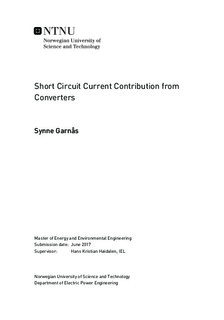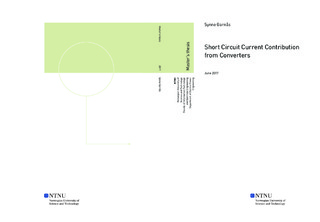| dc.description.abstract | The implementation of converter connected distributed generation in the grid is increasing. The converter enables control of the renewable resources' intermittent nature, which leads to regulation of voltage, frequency, and power output characteristics. This makes converters a preferable interface for renewable resources. The implementation of these units introduces new challenges in the distribution grid. One being a bi-directional power flow. This could be problematic for the traditional protection scheme, because it is based on an one-directional flow. Another challenge, is that the units can impact the short circuit level.
The scope of this master's thesis is investigating the short circuit current contribution from converters. Common practice today, is to operate with a rule of thumb saying that the short circuit current is one to two times the rated current. Therefore, the purpose of this thesis is to gain a deeper understanding of the converter short circuit behaviour, beyond the rule of thumb.
The hypothesis of this thesis, is that the short circuit current contribution from a converter is negligible. To investigate this hypothesis thoroughly, this thesis consists of a literature review, Simulink simulations and tests in the Smart Grid Laboratory.
The literature review corroborates the hypothesis to some extent. The review illustrates that the short circuit current contribution from a converter, is small. Some papers went as far as stating that the converter short circuit current contribution, is negligible. The results from the Simulink simulations showed that the short circuit contribution from one converter is small. However, this result is only accurate for the simplified control scheme implemented in the simulation model.
Some of the laboratory results also corroborate the hypothesis. Two different control schemes were tested in the laboratory. Control scheme 1 was directly controlling the reactive and active current, while control scheme 2 supplied AC voltage support to the grid. Different external factors and internal control settings were changed, to investigate the impact on the converter short circuit contribution. Results showed that the current contribution was largest with control scheme 2 implemented. However, even with this control scheme, the largest measured current was only 1.61 pu.
The findings in this Master's thesis, are not enough to make a general conclusion regarding the short circuit current contribution from a converter. To make such a conclusion, more research is needed. However, the findings have corroborated the hypothesis. | |

